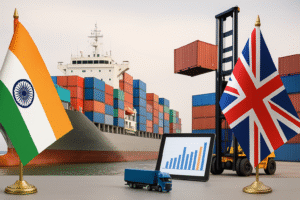
The media is abuzz with the Union Government’s recent decision to transform the Indian logistics industry with National Logistic Policy (NLP). The Government launched NLP on 17 September, 2022 to speed up the transformation of the Indian logistics sector. Indian Inc lauds this move, hailing it significant in boosting the ease of doing business and enhancing the liveability quotient. We decided to dig into this policy and unravel its significance in spurring India’s economic growth.
What triggered the need for launching NLP?
Logistics constitutes the backbone of India’s international trade. It plays a key role in bolstering the country’s manufacturing and exports. Compared to developed countries, the logistics cost in India has been higher. This high cost lowers the competitiveness of Indian goods both in domestic and export markets. Furthermore, it impairs efficiency across various sectors of the economy, impacts employment opportunities and mars economic growth.
How does NLP aim to boost the economy?
Both the government and industry insiders opine that NLP will transform the country’s logistics ecosystem. This policy aims to effect the following outcomes:
- Swifter and seamless movement of cargo and people
- Expedition of last-mile delivery, helping businesses save time, money and resources
- Creation of a single point of reference for all matters related to logistics and trade facilitation
- Substantial reduction in transportation costs and increased efficiency across supply chains.
- Ushering of blockchain and artificial intelligence to organise the unorganised logistics industry
- Facilitation of a modal shift in logistics — lowering the current over-dependence on roads to railways and waterways
- Reduction in the logistics cost from 14-18% of GDP to global best practices of 8%. This single-digit cost-to-GDP ratio is at par with those of countries, such as the US, South Korea, Singapore, and some European nations. In 2018, India ranked 44th in the Logistics Performance Index (LPI). With the launch of NLP, the country aims to be among the top 10 in the LPI by 2030.
Plans to effect NLP
The government has planned to develop the following initiatives as part of NLP.
Unified Logistics Interface Platform (ULIP):
This platform will:
- Unify all the digital services related to the transportation sector into a single portal.
- Spare the manufacturers and exporters from cumbersome processes.
- Ensure swifter and smoother cargo movement.
- Enable information exchange confidentially on a real-time basis.
It will make workflow seamless and faster resulting in greater efficiency in the logistics sector.
Ease of Logistics Services (E-Logs):
This platform will:
- Enable speedy resolutions of operational issues by facilitating direct interaction of businesses and industry associations with government agencies.
- Ensure transparency, accessibility and ease of business.
Integration of Digital System (IDS):
It will digitally integrate systems of different departments — road, railways, aviation, commerce ministries and foreign trade.
This body will monitor all logistics-related projects on a regular basis to improve coordination across ministries and between the central and state government.
The government has also proposed the creation of a State Logistics Coordination Committee in every state of India. It will employ the Logistics Ease Across Different States (LEADS) index annually to evaluate every state’s performance. Additionally, the Union Government will provide a blueprint to the states to enhance their logistics efficiency. With NLP, the government will also facilitate a unified regulatory environment and institutional framework that will set up multi-modal logistics parks (MMLPs) as key markets.
Final thoughts
With NLP coming into action, the Indian logistics market would be worth around $ 215 Bn in the next two years compared to $ 160 Bn. As per the Investment Information and Credit Rating Agency of India Limited (ICRA), the logistics sector will develop at a Compound Annual Growth Rate (CAGR) of 10.5% through 2025 after growing at a CAGR of 7.8% over the past 5 years.
After a careful study of the policy, we are certain that NLP provides a framework to transform the logistics industry, making it sustainable and growth intensive. However, we second our PM in his statement that it is both policy and performance, which will eventually spell progress.







